THE IMPACT OF THE WAVES OF IMMIGRATION FROM 1930-1939 By Noah Gross
The impact of the waves of immigration to Mandatory Palestine, on the development of the “Yeshuv” cannot be overstated. The Fifth Aliya, was relatively an enormous wave of immigration. Between 1930 and 1939, an estimated 250,000 Jews, mostly from eastern Europe, immigrated to MP, doubling the size of the Jewish population to 400,000 at its end. The rise of the Nazi party in Germany and anti-Semitism in Europe
were a driving force behind the fifth Aliya, 40% of which came from Poland and 25% of them from Germany, which gave this wave a distinct cultural tone.
In 1933 a treaty was signed between the Jewish agency and the Nazi party trading the nationalized Jewish property of German Jews immigrating, for goods and funds sent to MP. This treaty allowed the immigration to continue and provided a financial mans for the recovery of the Israeli economy after the crisis of the late 1920’s.
The new British High Commissioner, Arthur Walkof, who came into office in 1931, had a very pro Zionist stance, supporting immigration, the economy and the “Yeshuv”. This wave was characterized as consisting mostly of the middle class, free professions, merchants and industrialists. Tel-Aviv became the largest city, and in Haifa the Jewish population became the majority. Nearly 100 new agricultural settlements were established, double the number of the past 50 years.
The political left was led by David Ben-Gurion and the political right was led by Zeev Jaboinsky. Both camps had grown and the tensions between them had risen to new heights as well. These tensions were not confined to the pages of newspapers and debates and had turned into physical violence between supporters of both camps. Political groups that represent a segment of society flesh out their ideologies through institutions and organizations. The youth movements, sport guilds, and security organizations were the avenues through which the two factions expressed themselves.
The role of the youth movements and sports clubs was to recruit succeeding generations and to inculcate them ideologically and physically. The security organization was the expression of the political faction’s outlook on security regarding the threat it perceives from outside- the Arab population, the British Mandate and the opposing political faction. Since there were three fronts that the faction had to deal with, their training had to effectively respond to each threat as required.
The politicization of the Yishuv was so deep, that there was no place untouched by it. The youth movements were ideological from their genesis and they identified with their respective faction that matched their worldview. The sports clubs also became identified with the factions, even though the oldest sports club, Maccabi, tried to maintain a neutral standpoint. The educational system was the last bastion to fall to politicization. It started out in neutrality but succumbed to politicization in early 1940’s with the establishment of the “Hagam” training program and discrimination against members of “Betar”.
On this backdrop the 1930’s were a time of much activity and growth in the field of hand to hand combat.
In 1930 Moshe Feldenkaris published what is considered to be the first ever Hebrew book on self-defense. It was titled “Jiu-Jitsu and Self-Defense”, was 100 pages long, had 66 photographs and described 118 techniques.
The book can be seen as Moshe’s response to the 1929 riots. Feldenkrais had been a member of a self-defense group in Tel-Aviv. This group had received instruction in Jiu-Jitsu from a German born “Gimnasya Herzeliya” student. Moshe himself had completed his high school education at the “Gimnasya” from age 20 to 23 as an external student. According to Feldenkrais, when the riots of 1929 broke out, many of the group members went out to meet the rioters in hopes of defending their community. Every one of them who did, had either been killed or injured. He had chosen not to engage the rioters who had been armed with knives, sticks and swords.
The shock of this colossal failure on the part of the members of the self-defense group led Moshe to rethink his training and embark on a quest to find a realistic method of training which would prepare a person for the realities of violence. Emil Avineri served as a training partner during this time of research. The conclusions of his research were published in his book on self-defense which was the first of its kind to have been published in Hebrew.
Shortly after publication Feldenkrais left for France to study at the Sorbonne and out of fear that the British authorities may be looking at him unfavorably for publishing the book. The book had circulated among “Hagana” members and may have actually been financed by the “Hagana”.
The “Hagana” was still not very well organized and lacked any semblance of a coherent and universal hand to hand combat system taught to all members. In fact, there is no evidence that there had been any such training program beyond local initiatives. The Hagana’s response to the 1929 riots, was a reorganization in an attempt to remedy failures and recognized deficiencies in the organizations structure and functions. There was greater focus on training commanders, and over the next decade 10 courses took place. In these courses, 400 commanders were trained and served as the frame of command during the 1936-1939 great Arab uprising. The courses lasted from three weeks to three months. The content was frequently updated and the topics taught covered a wide spectrum of topics. The courses included: “Lessons learned from the riots, lectures and debates on tactics and strategy at a high level. Learning about topics relating to standing armies, guerilla warfare….” (source: wikipedia entry for the “Hagana”)
De facto the organization had been up until then, a loose network of local comities, in the different cities, whom acted independently most of the time. The “Yeshuvs” governing bodies recognized the need for a coordinated defensive effort under civil supervision. For this purpose, they formed the national command in 1930. The national command was subordinated to the “vaad Haleumi” and the Jewish Agency headed by David Ben-Gurion. The central command was a Parity Committee representing both left and right political camps. While this structure was enacted to solve problems in actuality it caused much friction and slowed down many decision-making processes. In addition, Ben Gurion’s position in the structure set him up as the de facto commander in chief, thus giving “Mapai” (the workers party) a majority in the “Hagana” command.
Politics plagued the organization and the fight for control was bitter.
In 1931 Avraham Tehomi, one of the top commanders in the “Hagana” was ousted from his position as the commander of the Jerusalem branch. Tehomi an admired leader in the “Hagana” had voiced criticism of the “Hagana”s response to the 1929 riots, which he called passive. Tehomi was accused of having ties with “Betar” and the revisionist movement led by Jaboinsky. His ousting caused many of the Jerusalem Hagana members and commanders to leave with him. Tehomi banded together with a group of activists in Tel-Aviv, led by Moshe Rosenberg and Yermiyahu Helpren. They formed the “Irgun bet” which later became the “Etzel” – (Ergun Tzvai Leumi – National military organization).
Jermiyahu Helpren, son of the legendary Michael Helpren, had been an activist in the “Hagana” from a young age. At 19 he had been an aide to Jabotinsky during the 1920 riots and after Jabotinsky’s arrest had been an aide to Pinchas Rotenberg, the head of the “hagana” at the time. He joined “Betar” in 1927 and then left the “Hagana” the following year as political persecution intensified within the organization. In 1930 he was appointed by Jabotinsky, as an officer and was entrusted with the task of setting up and managing a permanent section for defensive training within “Betar”. Between the years 1931-1933 Helpren traveled across eastern and western Europe setting up schools for Sergeants-instructors, in “Beitar”.
During his years of activity he wrote instructional material, taught and managed the defensive training section. He was responsible for training 500 defensive training instructors (sergeants) and 1500 assistant instructors (deputy sergeants) all of which served as instructors of Betars military squads.
The hand to hand combat curriculum at these training programs included; Boxing, Jiu-Jitsu, fencing and stick fencing. “Beitar” was extremely popular among Jews in eastern Europe and counted tens of thousands of members.
during these years, there was a lot of tension and violence between left and right political camps among the Jews of eastern Europe and Mandatory Palestine.
One of the lead figures in the instruction of defensive skills in “Beitar” in Europe was Avigdor Victor Mirkin. Mirkin was born in Russia and raised in France. He had a degree in law and was lieutenant in the French army. His training had been in the Barbaseti style, and he had taught fencing to the military forces in Paris. Mirkin was also an amateur boxer who on occasion competed and was a third Dan in jujutsu. He had been the founder of the “Betar” Paris Jiu-Jitsu club and had for a while collaborated with Moshe Feldenkrais who had resided in Paris during these years. Between 1931-1935 he taught jujutsu boxing and fencing to members of “Betar” youth movement, all over Europe. He immigrated to Palestine and took up teaching jujutsu. In 1935 Mirkin immigrated to Palestine and settled in Haifa, working as manager For “Pica” (פיק”א) (Palestine Jewish Colonization Association) and in his spare time teaching jiujitsu under the banner of the “Macabi” sports club in Haifa.
Arye Bayevsky was another instructor active in the late 1920’s and early 1930’s. He had gained his military experience as an officer in the Imperial Russian Navy and became an instructor at the school prior to immigrating to Palestine. Bayevsky had also been an instructor for the “Hagana” before he left its ranks and becoming an instructor at the “Betar” School for leaders/Instructors in Tel-Aviv. He is considered to be the person responsible for the stick fencing method practiced by “Betar” members between 1928 up to the mid 1940’s.
“Hapoel” the workers sports movement founded in the second half of the 1920’s saw considerable growth in the first half of the 1930’s. Like many organizations it started as a grass roots movement and slowly transformed into an organized sports club associated with the labor movement and politics. In its early years, local initiatives led to the creation of a small group in Jerusalem called “Hasadran”. Its original meaning and context was that of keeping order in a cinema, hence meaning usher or steward, but it also meant bouncer.
this small group over time addressed issues of public safety more and more.
By the 1930’s the concept spread to other affiliate “Hapoel” clubs in other cities.
“Hasadran” served as a core group of dedicated “Haopel” members who devoted their time to issues of security. Between 1930 and 1935, “Hapeol” and “Hasadran” went through several developmental stages.
In 1930 Ben-Gurion took practical steps to start the paramilitary framework inside “Hapoel” modeling it on the Austrian “Schutzbund”. Initially he brought Israel Shochat to lead “Hapoel” (March 1930) and various other former “Hashomer” members. Mordechai Mokasei emphasizes and says that “Ben-Gurion as Secretary-General of the “Histadrut” decided to add to the secretariat of “Hapoel” the “Hashomer” members Israel Shochat and Eliezer Kroll, with a clear purpose in mind: to improve fitness, training in semi-military subjects and Kapap” (note that Kapap was a later term referring to hand to hand combat).
This group acted to change the organization via getting funding, building apparatti, changing activities, bringing youth to “Hapoel”, building new frameworks and conducting courses and appropriate training. In the work of the “Hashomer” members in “Hapoel” there was much emphasis that the attribute most important in training for defense was the mental dimension, fighting spirit, dedication, and courage. In 1931 the Sadran members still trained in drill and ceremonies and jujutsu and their membership was quite small.
The next stage of development took place between 1932-1933, the birth of “Ish Hamishmar” (the guardsman). In 1932 strife continued to grow between Left and Right factions, and it reached a peak with Jabotinsky’s call to break “Histadrut” and its yearning for monopoly and hegemony. With growing harassment from “Betar” members towards rallies and processions of the “Histadrut”, a new framework was decided for the “Hasadran”. In the general meeting in 1932 there was already a consensus in that the “Hasadran” would be similar in its nature to the Austrian “Schutzbund” and it received a major boost from the Hapoel’s management. In December of that year Aba Hushi developed a plan for organization of “Hasadran” and turning it into a semi-paramilitary group. His plan included training in wrestling and jujutsu, the shot put, marksmanship, riding bicycles and horsemanship. The purpose of the platoons were to protect the “Histadrut” and its institutions, leadership and members, Ben-Gurion saw in his vision a socialist “Guardsman”.
Violent confrontations happened between worker groups and “Betar” members in many settlements and grew to a peak in “Kfar-Saba”. As if this was not enough, Chaim Arlosoroff (one of the ideological leaders of the left), was murdered in June 1933. During the months of July- September 1933 the “Hasadran” was reorganized according to the plans of Ben-Gurion and Aba Hushi, who saw that the time came for the formation of platoons in the new framework. The renewed organization filled its ranks with new members who took the place of the old ones, whom had been perceived as not possessing the attributes desired by the organization leaders. The new organization was obedient to the Histadrut’s will, who was in charge of training and guiding the “Hasadran”. This was a step upwards, but it was far from establishing a well constructed system for instruction and certification that includes research, distribution and dissemination of professional literature. Despite this the organization fulfilled its goals when it met and swept aside the Revisionist through might.
In the professional arena a new instructor was added by the name of Gershon Kopler, a new émigré from Austria had received his training in swimming, boxing and Jiu-Jitsu, as a member of the Austrian “Schutzbund” Kopler started out as a laborer by day and a traveling instructor in the evenings.
“Hapoel” published the magazine “uzenu” (our courage) in which the first issue included an written article by Yitzhak Sadeh where he stated the motto “for the masses, not for the champions”. This exhortation of a new paradigm that guided “Hapoel” would influence the approach to training and preparing people for self -defense and combat.
1934-1935 marked the transition from pre-emption of violence instigated by the Right, to violence being initiated by the Left. The “changing of the guard” in “Hasadran” that started at the end of 1933 and continued into the early months of 1934. The volunteers to “Hasadran” were 18-25 year old’s and were supposed to serve for two years in platoons that had 34 members and more, in groups of 17 people and in cells of eight. Violent confrontations between the two factions continued, and unlike other years, often they were initiated by “Hasadran” members. The scope of violence drew harsh criticism in the general public and in the end of 1934 Ben-Gurion changed direction and tried to talk with the Revisionists. Once the fear of the Revisionists and tension with them had lessened somewhat, the “Haganah” leadership could feel confident in terms of the status of the organization and its ability to serve the Yishuv. In the “Haganah”, which was trying to maintain a bipartisan status, there was a fear among its leaders, that “Hasadran” would develop into an autonomous body controlled by the “Histadrut”.
Elihu Golomb and his supporters feared the development of an independent military body that is not obedient to the “Haganah” and especially they feared Israel Shochat. Hence “Hasadran” was to exist, but only under the supervision of the “Haganah”. Pressure from this faction led to the resignation of many of the former members of “Hashomer”, from “Hapoel’ in 1934. “Hashomer” veterans had laid the basic foundation and framework organizationally and tactically basics for what was to follow in the “Plugot Hapoel” (Haopel platoons).
In 1935 after a long struggle for the leadership of the “Hanhala hazionit” the Revisionists led by Jabotinsky, broke away from the organization whom elected Ben-Gurion to lead it.
“Hasadran” had been groomed to be a defensive force against Right-wing faction violence, but from the moment Ben-Gurion was made leader of the entire Yishuv, he maintained a calm and compromising demeanor in regards the Right and even held talks with its representatives attempt to stop the violence between the factions. This change in Ben-Gurion’s approach was expressed in his distancing from “Hasadran” and removing his support from the organization, to the point that in 1936 it was disbanded.
At the level of instructor of hand to hand combat disciplines and spread of the practice, there was a marked growth. Both In “Macabi” and “Hapoel” Jiujitsu, Boxing, Fencing and Wrestling sections grew with them came a growth in training within the “Hagana” in these disciplines. It was still very small scale and far from being an organized systemic endeavor. In Jerusalem Avraham Meshorer was training “Hagana” members in Jiujitsu, Miniks was teaching Jiujitsu for “Hapoel”.
Two new emigres joined “Hapoel”s roister of instructors and would become central figures for a considerable time. Gershon Kopler Immigrated in 1933 settling in the north of the country. He started out as a day laborer and worked as a traveling instructor in the evenings. Kopler received his training in swimming, Boxing and Jiu-jitsu as a member of the Austrian “Schutzbund”.
Yitzhak Shtibel came as a member of the Polish team, participating in the second Maccabiah (“Macabi” Olympics), in April 1935. Shtibel, a member of the Boxing team, decided to stay in Palestine and taught Boxing in “Hapoel”.
Jiu-Jitsu was starting to become known and was still in its infancy in the early 1930’s. Boxing to saw considerable growth, especially in Tel-Aviv with Emil Avineris club “Beni-Leonard” and the organization of boxing matches between the different sports clubs, with British mandate peroneal and even sports clubs in neighboring countries.
In 1930, Avineri instructed at the first course on Boxing held by “Macabi. At other times he instructed for “Betar” Tel-Aviv and “Betar” Petach-Tikva. Among his accomplishments were victories against the middle weight champion of Egypt who would later be known as General Naguib, the leader of the officers coup of 1952, and winning a match against the champion of the French forces in Syria and Lebanon. In his last competitive match in 1934, he won against the champion of the British air force in Palestine. Boxings popularity is evidenced by a report in the “Palestine Post” from 1933. The reporter describes the bloody battle between two Boxer played out in front of an audience of 3000. Fencing also spread and grew but had less of presence within the circles of self-defense training.
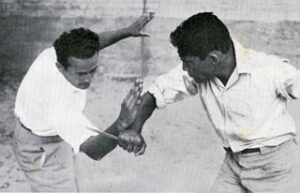
Moshe Feldinkrais and Emil Avineri 1930-1931
from the book: “Jiu-Jitsu and self-defense”
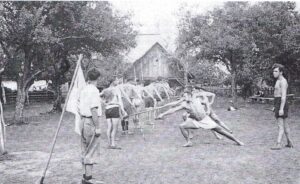
“Betar” instructor school Europe 1932
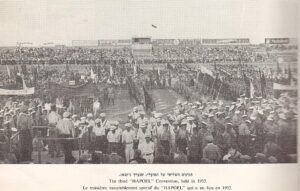
Third “Hapoel” convention, 1932
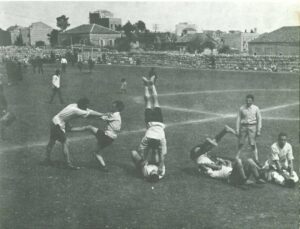
Avraham Meshorer standing behind his students (“Hagana” operatives), demonstrating Tomoe- Nage sacrifice throw. Jerusalem 1931(photograph by Floa Tsivlin)
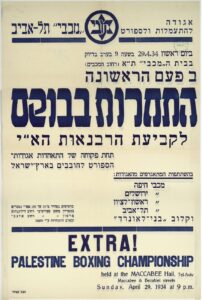
Poster for Boxing first Palestine Boxing championship among “Macabi” clubs and “Beni-Leonard”, 1934
